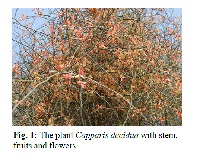Phytochemical and pharmacological Potential of Kair (Capparis Decidua)
Keywords:
Capparis decidua, traditional system of medicine, alkaloids, Phytochemical, PharmacologyAbstract
Capparis decidua (Forsk.) is belonging to family Capparidaceae, yet important medicinal plant of Indian Medicinal Plants. In the traditional system of medicine, the bark has been shown to be useful in the treatment of coughs, asthma and inflammation; roots used in fever and buds in the treatment of boils. In Unani, leaves act as appetizer, helps in cardiac troubles, fruits used in biliousness. The plant is reported to contain Phytochemicals including alkaloids, terpenoids, glycosides and some fatty acids. In Unani, leaves act as appetizer, helps in cardiac troubles, used in biliousness; alveolaris and pyorrhea; Root bark is used as anthelmintic and purgative. The plant have significant pharmacological activities like hypercholesterolemic, anti-inflammatory and analgesic, antidiabeti, antimicrobial, antiplaque, antihypertensive, antihelmintic & purgativ activities. The review analyses phytochemical and pharmacological potential of medicinal plant (kair).
References
Kaul RN. Need for afforestation in the arid
zones of India. La- Yaaran 13: 1963.
Ghosh RC. Handbook on afforestation
techniques. Dehra Dun, India, 1977.
Gupta RK., Prakash I. Environmental
analysis of the Thar Desert. Dehra Dun,
India, 1975.
Pandey AN, Rokad MV. Sand dune
stabilization: an investigation in the Thar
desert of India. Journal of arid environ 1992;
: 287-292.
Kirtikar KR, Basu BD. Indian Medicinal
Plants, Vol. II, 2nd Ed. (Lalit Mohan Basu
Prakashan, Allahabad) 1993. p. 197.
Sharma R. Medicinal Plants of India – An
Encyclopedia, (Daya Publishing house, New
Delhi); 2003. p. 42-43.
Chopra RN, Nayar SL, Chopra IC. Glossary
of Indian Medicinal Plants. (CSIR, New
Delhi); 1999. p. 49.
Rai S. Chemical examination of edible plants
of Rajasthan desert with special ref. to
Capparadaceae. Curr Agric 1987; 11:15-23
Ahmad VU, Ismail N, Arif S, Amber AR.
Isocodonocarpine from Capparis decidua.
Phytochem 1989; 28: 2493-2495
Dahot MU, Chemical evaluation of the
nutritive value of flowers and fruits of
Capparis decidua. J Chem Soc Pak 1993; 15:
-81
Ahmad VU, Arif SA, Amber R, Usmanghani
K, Miana GA. A new spermidine alkaloid
from Capparis decidua. Heterocycles 1985;
: 3015-3020.
Ahmad VU, Arif S, Amber AR, Fizza K.
Capparisinine, A new alkaloid from Capparis
decidua. Liebigs Ann Chem 1987;:161-162
Ahmad VU, Ismail N, Arif S, Amber AR.
Two new N- acetylated spermidine alkaloids
from Capparis decidua. J Nat Prod 1992; 55:
-1512
Gupta J, and Ali M. Oxygenated heterocyclic
constituents from Capparis decidua root bark.
Indian J Heterocycles Chem 1997; 6: 295-302
Manzoor-i-khuda, Jeelani NA. Pak. J Sci Ind
Res 1968; 11:250-252
Ahmed VU, Fizza K, Amber AUR, Arif S.
Cadabicine and cadabicine diacetate from
Crataeva nurvala and Cadaba farinose. J
Nat Prod 1987; 50: 1186
Gaind KN, Juneja TR. Capparis decidua -
Phytochemical study of flowers & fruits. Res
Bull Panjab Uni Sci. 1970; 21: 67-71
Goyal R, Grewal RB. The influence of Teent
(C. decidua) on human plasma triglycerides,
total lipids and phospholipids. Nutr Health
; 17: 71-76
Rashid S, Lodhi F, Ahmad M, Usmanghani
K. Preliminary cardiovascular activity
evaluation of capparidisine, a spermidine
alkaloid from Capparis decidua. Pak J
Pharmacol 1989; 6: 6- 16
Yadav P, Sarkar S, Bhatnagar D. Lipid
peroxidation and antioxidant enzymes in
erythrocytes and tissues in aged diabetic rats.
Indian J Exp Biol 1977; 35: 389-392
Agarwal V, Chavan BM. A study on
composition and hypolipidaemic effect of
dietary fibre from some plant foods. Plant
Foods Hum Nutr 1988; 38: 189-197
Yadav P, Sarkar S, Bhatnagar D. Action of
Capparis decidua against alloxan-induced
oxidative stress and diabetes in rat tissues.
Pharmacol Res 1997; 36: 221-228
Gaind KN, Juneja TR, Jain PC. Anthelmintic
and Purgative Activity of Capparis decidua
Edgew. Indian J Hosp Pharm 1969; 2: 153-
Mali RG, Hundiwale JC, Sonawane RSR,
Patil N, Hatapakki BC. Evaluation of
Capparis decidua for anthelmintic and
antimicrobial activities. Indian J Nat Prod
; 20: 10-13
Gaind KN, Juneja TR, Jain PC.
Investigations on Capparis decidua Edgew.
Part II. Antibacterial and antifungal studies.
Indian J Pharm 1969; 31: 24-25
Juneja TR, Gaind KN, Panesar AS. Res Bull
Punjab Univ Sci. 1970; 21: 519-521
Gaind KN, Juneja TR, Bhandarkar PN.
Volatile principles from seeds of Capparis
decidua. (Kinetics of in vitro antibacterial
activity against Vibrio cholerae, Vibrio
ogava, Vibrio inaba and Vibrio eltor). Ind J
Pharm 1972; 34:86-88
Purohit A, Vyas KB. Hypolipidaemic efficacy
of Capparis decidua fruit and shoot extract in
cholesterol-fed rabbits. Indian J Exp Biol
; 43 : 836-866
Sharma I, Gusain D, Sharma A, Dixit VP.
Hypolipidaemic effect of Capparis decidua
fruit extract (50% EtOH) in cholesterol-fed
rabbits. Indian Drugs 1991; 28: 412-416
Purohit A, Vyas KB. Antiatherosclerotic
effect of Capparis decidua fruit extract in
cholesterol-fed rabbits. Pharmaceutical Biol
; 44: 172-177
Ghulam S. The Phytochemical and
Phytopharmacological studies on Saraca
indica, Capparis decidua and Lotus gracinii.
Pakistan Reseach Repository, University of
Karachi, Karachi. 2002.
Behl, P. N., Captain, R. M., Bedi, B. M. S.,
Gupta, S. In skin irritant and sensitizing
plants found in India. Asian printers,
Bombay, 65-75, 1996.



